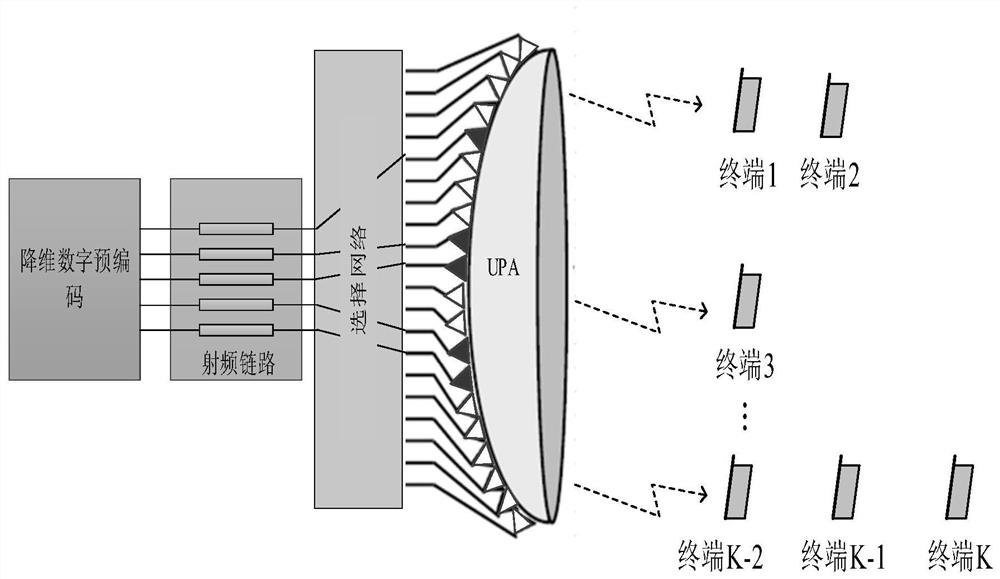Millimeter wave joint beam selection and power distribution optimization method
An allocation optimization, millimeter-wave technology, applied in the field of signal communication, can solve problems such as unconsidered interference between users, interference between users of terminal equipment, high power consumption, etc., achieve near-optimum spectral efficiency, solve interference between users, and use a large number of Reduced effect
- Summary
- Abstract
- Description
- Claims
- Application Information
AI Technical Summary
Problems solved by technology
Method used
Image
Examples
Embodiment 1
[0055] The system model, the millimeter-wave massive MIMO-NOMA system model based on the 3D lens antenna array uses a large-scale two-dimensional planar antenna array at the base station, which has the advantage of increasing the channel vertical dimension and forming a more accurate directional beam pair service area for more comprehensive coverage, such as figure 1 shown.
[0056] The millimeter-wave channel is sparse, and the physical characteristics of the millimeter-wave channel can be fully utilized to establish a theoretical analysis framework for a millimeter-wave mobile communication system based on a 3D lens antenna array. Considering a single-cell downlink communication system, the received signal vector y d It can be expressed as
[0057] the y d =H H u H FPs+n (1)
[0058] where y d =[y 1 ,y 2 ,...,y K ] T is the receiving signal vector; H=[h 1 , h 2 ,...,h K ] is an N×K-dimensional channel matrix, h k is the N×1-dimensional space domain channel vec...
Embodiment 2
[0072] Combined beam selection and power allocation technology, the key to the successful application of beam selection technology is to make full use of CSI to select the optimal beam and transmit accurate information. Under the condition that the system and rate are infinitely close to the all-digital system and rate, its power consumption and hardware complexity are far lower than those of the all-digital system. However, in the process of exploring beam selection technology, due to the existence of shared beams, the problem of inter-user interference often occurs. Therefore, if the problem of inter-user interference can be effectively solved, the overall transmission performance of the system can be greatly improved. In order to ensure that the beam selection algorithm proposed in the present invention has the superior performance of high sum rate, low complexity, and low power consumption, the present invention analyzes the characteristics of interfering users and non-inte...
Embodiment 3
[0156] The influence of different number of users on spectrum efficiency and energy efficiency is analyzed. In order to explore the influence of different number of users on the spectrum efficiency and energy efficiency of various algorithms, under the condition of different number of users, the full digital system, MM beam selection (two One beam serves one user), MS beam selection (one beam serves one user), IC beam selection (one beam serves one user), MM beam selection (one beam serves one user), and the joint beam selection and power allocation iterative algorithm (referred to as : The spectral efficiency and energy efficiency of PAI) have been compared with related simulations. Such as figure 2 It is a comparison chart of spectrum efficiency and energy efficiency of various algorithms under different number of users, where the number of antennas is 64, the SNR is 10dB, the number of users is 2-16, and the dimension of the channel matrix is up to 64×16.
[0157] from ...
PUM
| Property | Measurement | Unit |
|---|---|---|
| Snr | aaaaa | aaaaa |
Abstract
Description
Claims
Application Information
 Login to View More
Login to View More - R&D
- Intellectual Property
- Life Sciences
- Materials
- Tech Scout
- Unparalleled Data Quality
- Higher Quality Content
- 60% Fewer Hallucinations
Browse by: Latest US Patents, China's latest patents, Technical Efficacy Thesaurus, Application Domain, Technology Topic, Popular Technical Reports.
© 2025 PatSnap. All rights reserved.Legal|Privacy policy|Modern Slavery Act Transparency Statement|Sitemap|About US| Contact US: help@patsnap.com



